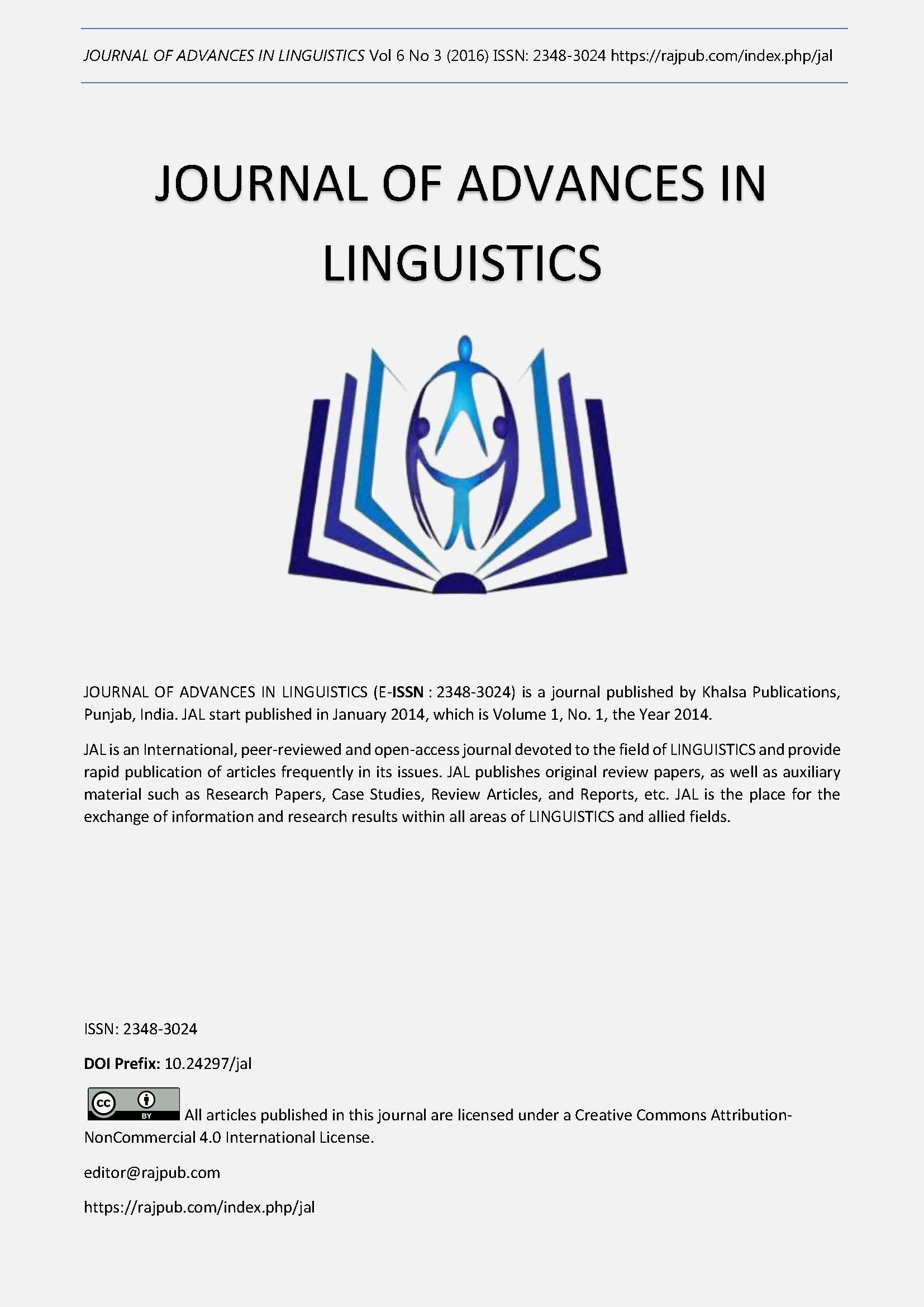An Optimality Theoretic Account of Place and Voice Assimilation in Bushehri Dialects
DOI:
https://doi.org/10.24297/jal.v6i3.4662Keywords:
Optimality Theory(OT), assimilation, acute, grave, Bushehr, dialect.Abstract
This paper intends to illustrate an analysis about one of the Common Phonological Processes in some regional varieties of Bushehri: assimilation, in the framework of Optimality Theory (McCarthy 2008). Bushehr Province with an area of 23167 square kilometers is located in south Iran. Speakers in this province can be divided in two general branches: northern and southern branches. Speakers in northern branch speak a dialect like Luri. Speakers in southern branch speak dialects that are like what is common in Fars Province. One of the taxonomy of assimilation is related to the influence of the sound features on the process of assimilation. This type of classification of assimilation can be according to two major parameters, place and voice. In Bushehri dialects there is a place assimilation in acuteness and graveness features. Hyman (1975 :31) argues that both consonants and vowels differ in this acoustic property of graveness/ acuteness. In Bushehri variteis, the back round vowel [u] before [+acute] consonants changes to front unround vowel [i] that has [+acute] feature. Also in Bushehri dialects when voicless palatal [c] placed before a voiced consonant, or when voicless alveolar [s] placed before a voiced consonant, they take voice feature from the voiced consonant and change to their adjacent pair [z] and [Ɉ]. Assimilation between adjacent segments is driven by the family of agreement constraints: AGREE [F]. Ranking AGREE[x] above IDENT[x] guarantees assimilation, in the other word the final ranking is as follow: AGREE [x] >> IDENT [x].Downloads
Download data is not yet available.
References
1) Bacovic, E., (2000). Harmony, Dominance and Control. Ph.D thesis, Rutgers University: New Brunswick, NJ. [ROA-360].
2) Bakovic, E., (2000). Local Assimilation and Constraint Interaction. de Lacy (ed.), The Cambridge Handbook of Phonology, 335-352. Cambridge University Press.
3) Beckman, J., (1998). Positional Faithfulness, Positional Neutralisation and Shona Vowel Harmony. Phonology 14, 1-46.
4) Carr, Ph., (1999). English Phonetics and Phonology; an introduction. Oxford: Blackwell.
5) Crystal, D., (2008). A Dictionary of Linguistics and Phonetics. Oxford: Blackwell.
6) Hyman, L., (1975). Phonology Theory and Analysis. New York: Holt, Rinehart & Winston. Pp. xiii+268.
7) Hyman, L., (1985). A Theory of Phonological Weight. Dordrecht: Foris.
8) Kager, R., (2004). Optimality Theory. Cambridge: Cambridge University Press.2nd ed.
9) Kar, S., (2009). Gemination in Bangla: An Optimality-theoretic analysis. The Dhaka University Journal of Linguistics 1 (2), 87–114.
10) Katamba, F,. (1989). An Introduction to Phonology. Addison Wesley Longman Publishing, New York.
11) Lass, R. (1984). Phonology: an Introduction to Basic Concepts. Cambridge: Cambridge University Press.
12) Lombardi, L., (1996a). Positional Faithfulness and Voicing Assimilation in Optimality Theory. Ms., University of Maryland, College Park.
13) Lombardi, L., (1996b). Restrictions on direction of voicing assimilation: an OT account. University of Maryland Working Papers in Linguistics 4, 84-102. [ROA- 247.]
14) Lombardi, L., (1999). Positional Faithfulness and Voicing Assimilation in Optimality Theory. NLLT 17, 267-302.
Butska, Luba. 1998. Faithfulness to [voice] in Ukrainian: An Analysis of Voicing Alternations within Optimality Theory. In R. Artstein and M. Holler (eds.), RuLing Papers 1 (Working Papers from Rutgers University), 59-73.
15) McCarthy, J. (2008). Doing optimality theory: Applying theory to data. Malden, MA: Blackwell Publishing. doi:10.1002/9781444301182
16) Trask, R. L., (1996). Dictionary of Phonetics and Phonology Taylor & Francis Routledge, London.
17) Windfuhr, G., (2009). The Iranian Languages. Routledge, Taylor & Francis Group, London and New York.
2) Bakovic, E., (2000). Local Assimilation and Constraint Interaction. de Lacy (ed.), The Cambridge Handbook of Phonology, 335-352. Cambridge University Press.
3) Beckman, J., (1998). Positional Faithfulness, Positional Neutralisation and Shona Vowel Harmony. Phonology 14, 1-46.
4) Carr, Ph., (1999). English Phonetics and Phonology; an introduction. Oxford: Blackwell.
5) Crystal, D., (2008). A Dictionary of Linguistics and Phonetics. Oxford: Blackwell.
6) Hyman, L., (1975). Phonology Theory and Analysis. New York: Holt, Rinehart & Winston. Pp. xiii+268.
7) Hyman, L., (1985). A Theory of Phonological Weight. Dordrecht: Foris.
8) Kager, R., (2004). Optimality Theory. Cambridge: Cambridge University Press.2nd ed.
9) Kar, S., (2009). Gemination in Bangla: An Optimality-theoretic analysis. The Dhaka University Journal of Linguistics 1 (2), 87–114.
10) Katamba, F,. (1989). An Introduction to Phonology. Addison Wesley Longman Publishing, New York.
11) Lass, R. (1984). Phonology: an Introduction to Basic Concepts. Cambridge: Cambridge University Press.
12) Lombardi, L., (1996a). Positional Faithfulness and Voicing Assimilation in Optimality Theory. Ms., University of Maryland, College Park.
13) Lombardi, L., (1996b). Restrictions on direction of voicing assimilation: an OT account. University of Maryland Working Papers in Linguistics 4, 84-102. [ROA- 247.]
14) Lombardi, L., (1999). Positional Faithfulness and Voicing Assimilation in Optimality Theory. NLLT 17, 267-302.
Butska, Luba. 1998. Faithfulness to [voice] in Ukrainian: An Analysis of Voicing Alternations within Optimality Theory. In R. Artstein and M. Holler (eds.), RuLing Papers 1 (Working Papers from Rutgers University), 59-73.
15) McCarthy, J. (2008). Doing optimality theory: Applying theory to data. Malden, MA: Blackwell Publishing. doi:10.1002/9781444301182
16) Trask, R. L., (1996). Dictionary of Phonetics and Phonology Taylor & Francis Routledge, London.
17) Windfuhr, G., (2009). The Iranian Languages. Routledge, Taylor & Francis Group, London and New York.
Downloads
Published
2016-06-15
How to Cite
Kambuziya, A. K.- e Z., Aryaei, P., & Khorshid, S. B. (2016). An Optimality Theoretic Account of Place and Voice Assimilation in Bushehri Dialects. JOURNAL OF ADVANCES IN LINGUISTICS, 6(3), 1000–1007. https://doi.org/10.24297/jal.v6i3.4662
Issue
Section
Articles
License
 All articles published in Journal of Advances in Linguistics are licensed under a Creative Commons Attribution 4.0 International License.
All articles published in Journal of Advances in Linguistics are licensed under a Creative Commons Attribution 4.0 International License.




